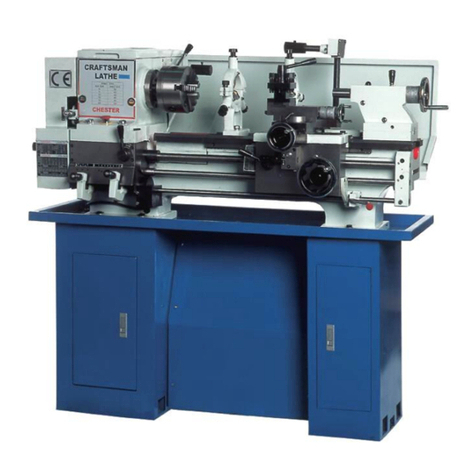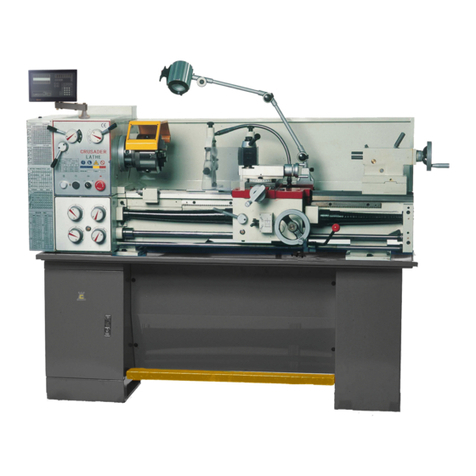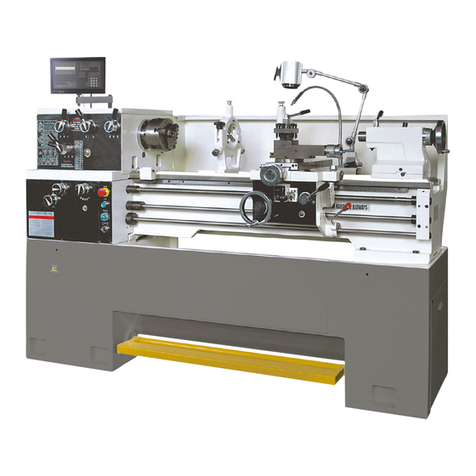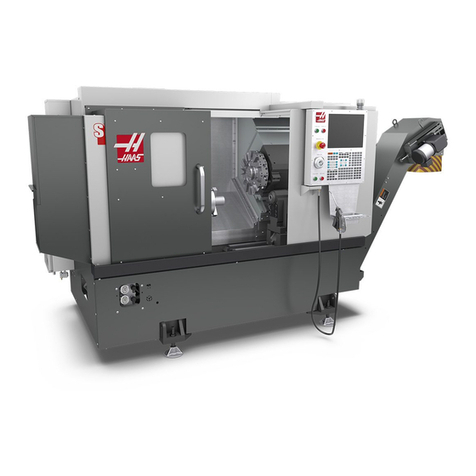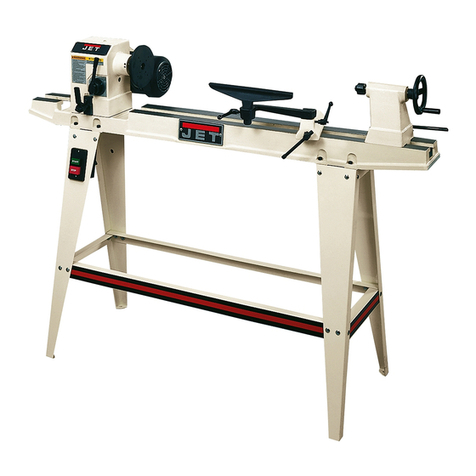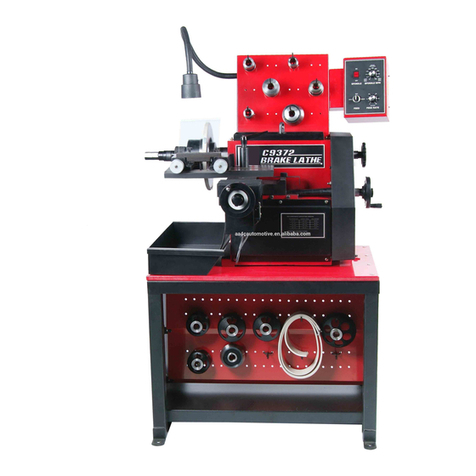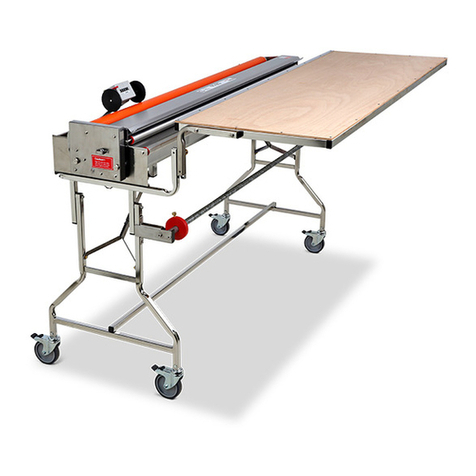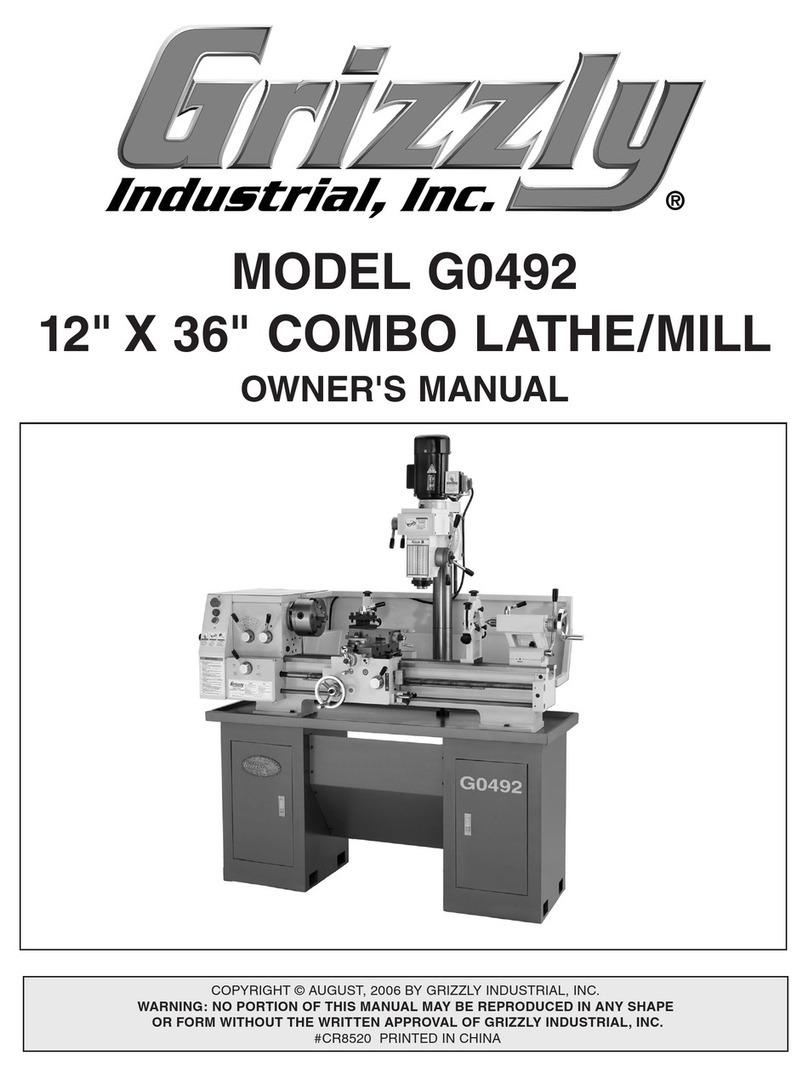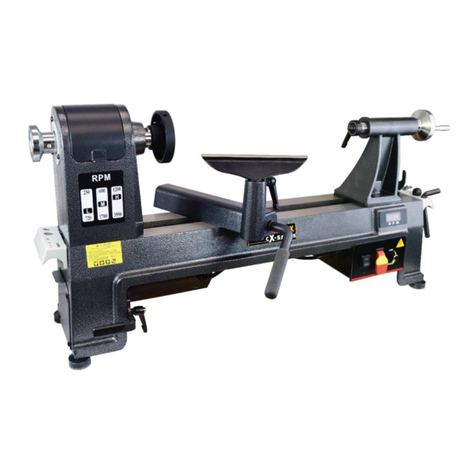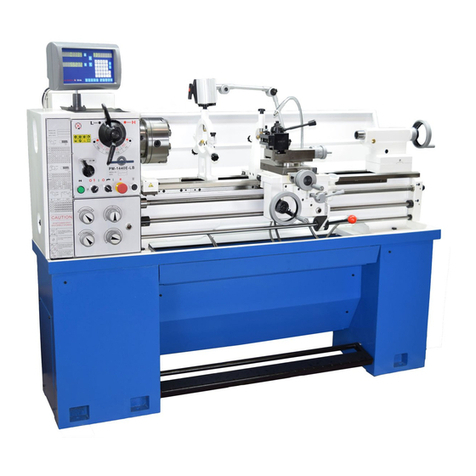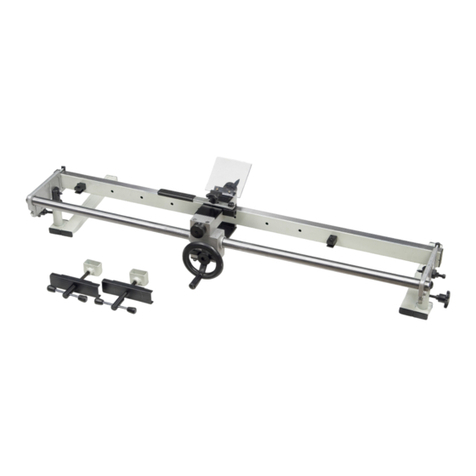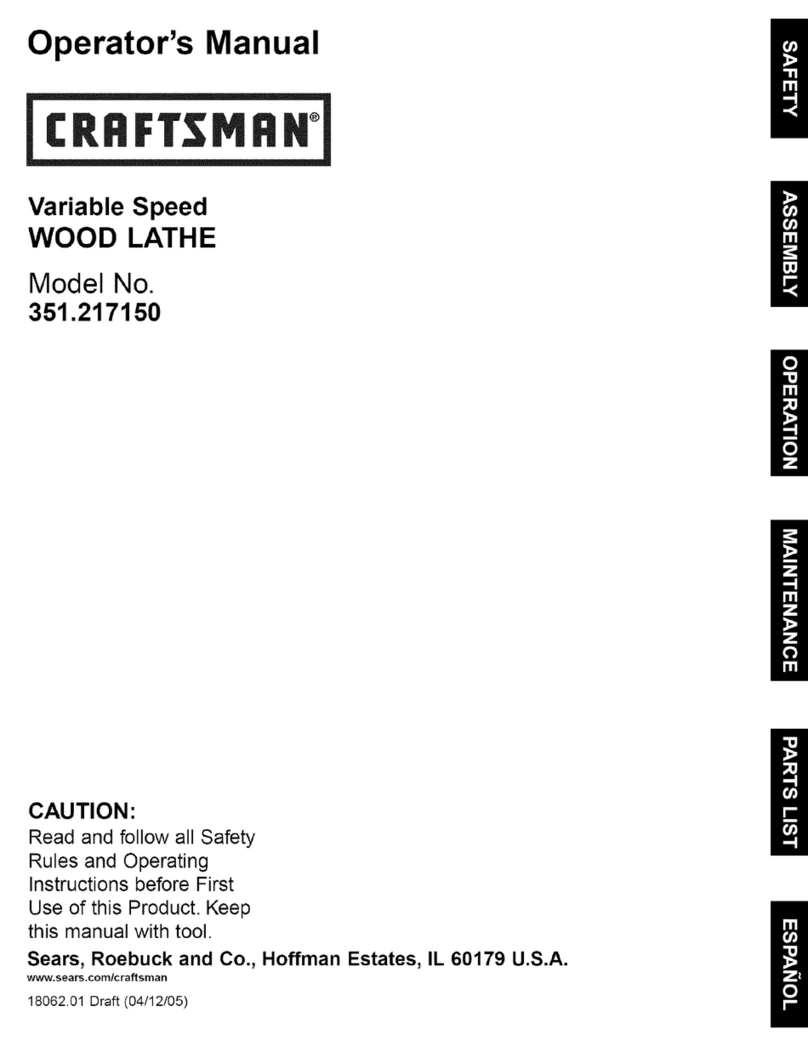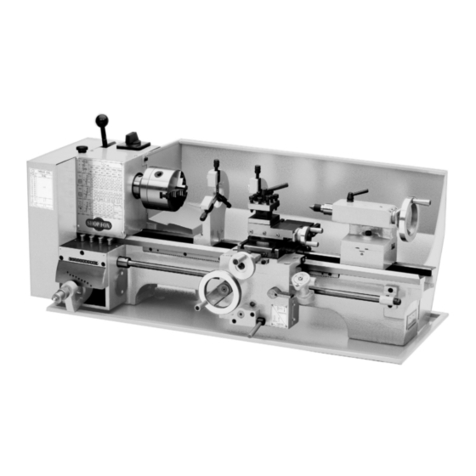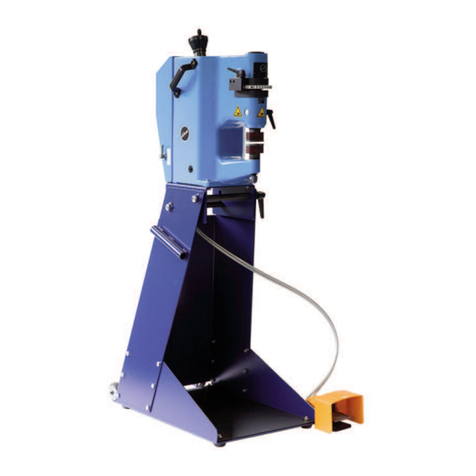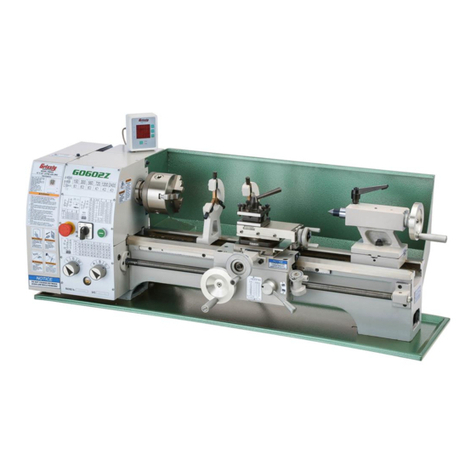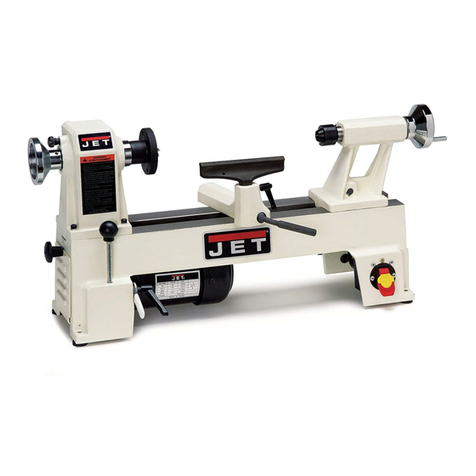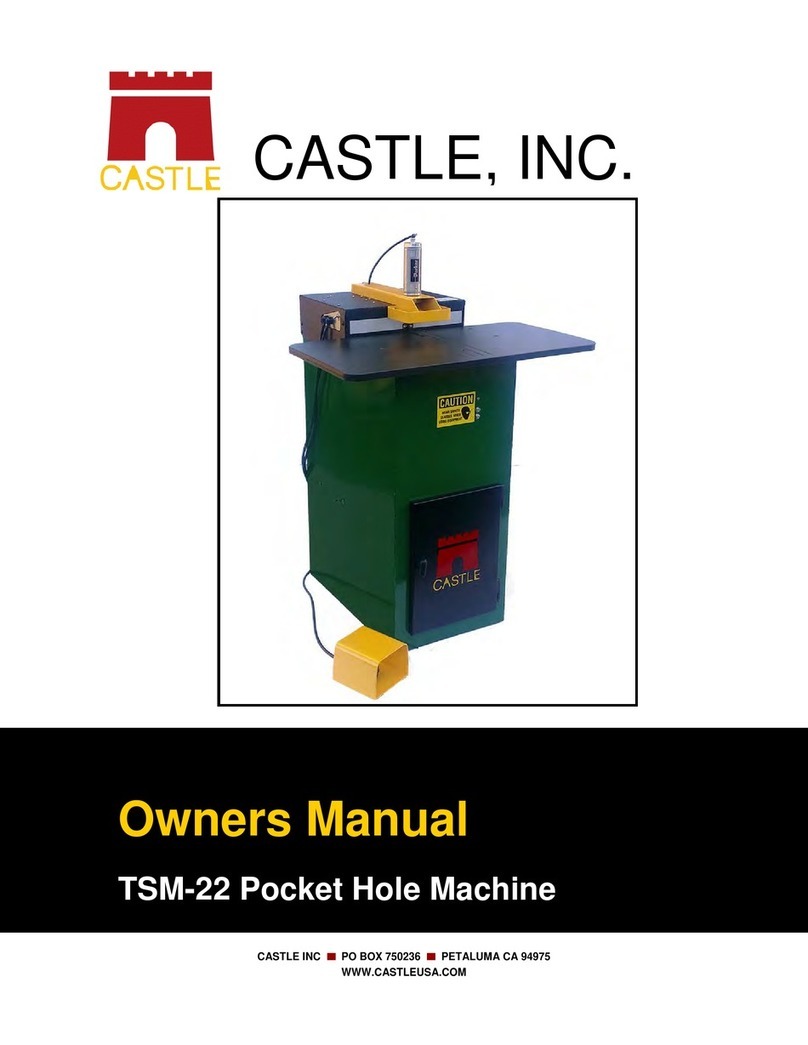CHESTER Crusader VS User manual

2
Contents
1. Safety Rules for Lathes
2. Machine Specification
3. Constructional Indication
4. Unpacking and Installation
4.1. Unpacking
4.2. Cleaning
4.3. Installation
5. Lubrication
5.1. Headstock
5.2. Gearbox
5.3. Apron
5.4. Change Gears
5.5. Other Parts
6. Test Running
6.1. Spindle Speed Control
6.2. Operation Symbols
7. Thread and Feed Selection
7.1. Thread and Feed Selection
7.2. Feed and Thread Tables
7.3. Threading Dial Indicator
8. Chuck and Faceplate Removal/Installation
8.1. Chuck and Faceplate Removal
8.2. Chuck and Faceplate Installation
8.3. Camlock Stud Installation
9. Maintenance and Servicing
9.1 Lathe Alignment
9.2 Saddle Strip
9.3 Cross Slide
9.4 Compound Rest
9.5 Cross Slide Nut
9.6 Tailstock Bed Clamp
10. Parts List.
Bed Assembly
Headstock Assembly
Feed and Change Gearbox Control
Apron
Cross Slide and Compound
Tailstock Assembly
Steady Rest and Follow Rest
Coolant System and Compound
Electric Assembly
Optional Accessories

3
1. Safety Rules for Lathes
Safety is a combination of operator common sense and alertness at all times when
the lathe is being used. Study these safety rules and general safety rules before
operating and retain this manual for future use.
1. Wear eye protection.
2. Never attempt any operation or adjustment if the procedure is not understood.
3. Keep fingers away from rotating parts and cutting tools while in operation.
4. Never force the cutting action.
5. Never perform an abnormal or little used operation without referring to the manual
and without the use of adequate blocks, jig stops, fixtures etc.
6. Use of a shop manual such as “machinery’s handbook” or similar is recommended
for cutting speeds and operation detail.
7. Do not remove the drive cover while the machine is in operation. Make sure that
it is always closed.
8. Always remove the chuck key, even when the machine is not in operation.
9. Do not attempt to adjust or remove tools when in operation.
10. Always keep the cutters sharp.
11. Never use the machine in an explosive atmosphere or where a spark could ignite
a fire.
12. Always use identical replacement parts when servicing the machine.
Warning: Do allow familiarity (gained from frequent use of your lathe) to become
commonplace. A careless fraction of a second can lead to severe injury.
2. Machine Specification
Bench lathes are especially suitable for machining, tool toms and repairing working
shops to machine shafts, sleeves and disc workpieces of medium and small sizes.
They can also be used to cut metric thread and imperial, with compact construction
and reasonable composition, they can cut very well. They are easy and reliable to
operate, convenient to repair, high in efficiency and have low noise levels.
Technical Specification
Type
VS3
VS4
Swing over bed
356mm
356mm
Swing over cross slide
230mm
230mm
Swing over gap
450mm
476mm
Carriage travel
710mm
960mm
Cross slide travel
178mm
Top slide travel
90mm
Tailstock quill travel
100mm
Tailstock taper
MT4
Bed width
186mm
Spindle bore
51mm
Cam lock system
D5
Spindle speed
70-2000rpm
Spindle taper
MT6
Cutting tool (max section)
20 x 20mm

4
3. Constructional Indication
No
Name
No
Name
1
Speed selector
22
Apron
2
Headstock
23
Threading cutting engagement lever
3
DRO for spindle speeds
24
Control lever
4
Feed direction selector
25
Cross travel control handwheel
5
Change gear box
26
Saddle
6
Feed box selectors
27
Cross slide
7
Feed gear box
28
Support casting
8
Demarcation frame work
29
Bed way
9
Leadscrew and safety guide
30
Tailstock set-over screw
10
Feed rod
31
Tailstock
11
Control bar
32
Quill travel handwheel
12
Oil Tray
33
Tailstock lock leer
13
Left stand
34
Quill lock lever
14
Indication light
35
Coolant system
15
Inching Button
36
Compound rest handwheel
16
Spindle speeds adjustable knob
37
Compound rest
17
Coolant knob
38
Tool post
18
Emergency stop button
39
Work light
19
Foot brake
40
Spindle and chuck
20
Right stand
41
Safety cover for chucks
21
Longitudinal traverse handwheel
42
Electric box

5
4. Unpacking and Installation
4.1 Unpacking
Unload the machine with a tackle, using clamping plates and eyebolts. Keep the
machine in balance by moving the tailstock and the bed slide to the right. Avoid using
sling chains as they could cause damage to the feed rod and the leadscrew. Lift the
lathe carefully and place it softly onto the floor or the workbench.
4.2 Cleaning
Before putting the machine into operation, use kerosene (paraffin) or white spirit to
remove the anti-corrosion coating or grease from all the slideways and the gear train.
Do not use lacquer thinner or other caustic solvents. Oil all bright machine surfaces
immediately after cleaning. Use heavy oil or grease on the change gears.
4.3 Installation
Place the machine on a solid
foundation. A concrete floor is the
best base for the machine (if
necessary, use an under frame
operational). Make sure that there is
sufficient space around the lathe for
easy work and maintenance. Use a
precision level on the bed way to make
further adjustment for level condition,
then tighten the foundation bolts
evenly and finally recheck the
machines level.
5. Lubrication
Before putting the lathe into operation, make the following lubrication check.
5.1 Headstock
The bearing of the headstock turns in an oil bath. Ensure that the oil level reaches
three quarters of the oil gauge glass.
When changing the oil, remove the end cover and the change gears with swing frame.
Drain off the oil by removing the drain plug on the bottom of the headstock. To fill,
take off the headstock cover. Check the oil level regularly. The first oil change should
be made after 3 months, then the oil should be changed annually.
5.2 Gearbox
Remove the end cover to expose the filling plug. Fill the tank with Shell Tellus 32 until
the oil level reaches the mark in the oil sight glass. The first oil change should be
made after three months then once every year.
5.3 Apron
The oil bath is filled with Shell Tellus 32 through the filling plug on the right side of the
apron. Check the oil level in the oil gauge glass on the front of the machine regularly.
The fist oil change should be made after three months then once a year. When
replacing the oil, drain the oil by removing the oil drain plug from the bottom of the
apron.

6
5.4 Change Gears
Lubricate the change gears with thick machine oil or grease once a month.
5.5 Other parts
There are other lubricating points on the input shaft bracket of the gearbox, the
handwheel on the apron, the longitudinal and cross slide, the thread dial indicator, the
tailstock and the bracket. Use a grease gun to put a few drops of oil onto the
lubricating positions from time to time. Lubricate the apron worm and worm gear, half
nut and leadscrew twice a month. Apply a light film of oil to the bed way and all the
other bright parts like the tailstock quill, feed rod etc. once a day.
6. Test Running
6.1 Spindle Speed Control
A. Identification before operation
Ensure that lubrication has been carried out as described before.
When the main spindle is rotating, the gearbox and the feed axis of the bed sides are
put into operation. The forward/reverse switch (4) should be in the neutral position.
The feed axis selector (6) and feed/thread selector handle (6) are in the disengaged
position. Under these circumstances, both the longitudinal travel handwheel (21) and
the cross travel handle (25) can be operated by hand.
B. Main spindle rotation
The main spindle rotation is selected by the forward/reverse switch.
C. Main spindle speed
The speed of the main spindle is selected by the high/low speed selector (1). For both
the high and low speeds, there are two different positions. For the correct speed, refer
to the speed chart. Never change the speed before the motor has stopped completely!
Adjustment of the speed can be assisted by turning the main spindle by hand.
D. Running In
Running in should be done at the lowest possible speed. Let the machine run at the
lowest speed for approximately 20 minutes, then check for any irregularities. If
everything seems in order, gradually increase the speed.
E. Operation
Only use high peripheral speed type chucks.
The maximum spindle speed for chuck plates with a 250mm should not be more than
1255rpm. When thread cutting or auto feeding are not in use, the feed/thread selector
should be in the neutral position so to ensure the disengagement of the leadscrew and
the feed rod. To avoid any unnecessary wear, the thread dial indicator should be out
of mesh with the leadscrew.

7
6.2 Operation Symbols

8
7. Thread and Feed Selection
7.1 Thread and Feed Selection
All threads and feeds are indicated on the tables fitted on the front of the change
gearbox. They are selected with the feed selector handles (6) on the feed gearbox.
A. Manual Operation
The carriage is moved by the handwheel (21), the cross slide handwheel (25) and the
compound rest handwheel (36). The slide can be anchored by turning the lock bolts
on the top and side of the slide.
B. Feed and Thread Tables
Longitudinal and cross feed table. Metric and imperial thread table.
C. Automatic Feed operation
Engage the 40T change gear at the transmission shaft and the 127T intermediate gear
with the feed direction selector (6) then set the feed/thread selector (6) to the left hand
position and position one lever at any of the 1-5 hole, the other at the A-E holes. The
feed rod will rotate. If the selector is pushed upwards, a longitudinal feed can be
obtained. If the selector is pushed down, across feed will be obtained.
D. Thread Cutting Operation
The direction of thread cutting is controlled by the feed director (6). By operating the
feed selector handle and the feed/thread selector handle according to the thread pitch,
the leadscrew will rotate. Operate the handle (23) down to engage with the leadscrew
to achieve the longitudinal travel of the thread cutting feed.
7.2 Feed and Thread Tables
A. Feed Table
Longitudinal and cross feed table for a metric
lathe.
Longitudinal and cross feed for an imperial
leadscrew.

9
B. Thread Tables
Thread table for a metric leadscrew
Thread table for an imperial leadscrew
7.3 Thread Cutting Operation
In order to obtain the desired thread, all the correct change gears must be installed in
strict accordance with the chart. Failure to do so will give incorrect threads.
Rotate the leadscrew by operating the feed/selector to any position and be sure the
feed selector handle is engaged. Operate the thread cutting engagement lever
downwards to engage with the leadscrew to obtain the longitudinal travel of the
carriage, i.e. the thread cutting feed. Make sure that the feed axis selector is
disengaged (at the neutral position) before operating the thread cutting engagement
lever as there is an interlock mechanism between the auto feeding and thread cutting
engagement. The direction of the thread can be chosen by turning the feed directing

10
selector at the headstock. There are 31 thread pitches in imperial and 26 metric
pitches which can be obtained by turning the feed selector handles.
A. Thread Dial Indicator
The thread dial indicator is installed on the right hand side of the apron. The indicator
is used for thread cutting to engage with the leadscrew.
To reduce the amount of wear on the thread dial indicator, the unit should be
disengaged by the swinging the pinion out of mesh with the lead screw when not in
use.
For these threads it is recommended that the thread dial indicator be used as this
allows the half nut of the leadscrew to be engaged at the end of the end of each thread
cutting pass, provided that they are re-engaged in accordance with the indicator table
mounted in front and down of the change gear box.
In column 1: millimeter pitches to be cut.
27T, 28T, 30T: The number of teeth in “pitch-off gear” arranged to mesh with the
leadscrew (this being selected from the stack, stored on the bottom of the dial spindle).
Dial graduation:
The dial numbers at which the half nut may be engaged under numbers of teeth of
pick-off gear.
Metric leadscrew machines (Metric thread only), the table shows:
Imperial leadscrew machines (imperial thread only), the table shows:

11
8. Chuck and Faceplate Removal/Installation
When fitting chucks or faceplates, ensure that the spindle and the chuck taper are
correct when mounting a new chuck to re-set the cam lock studs (A). Remove the cap
head locking screws (B) and set each stud so that the scribed ring (C) is flush with the
rear face of the chuck with the slot lining up with the locking screw hole.
Mount the chuck or the faceplate on the spindle nose and tighten the six cams in turn.
When fully tightened, the cam lock line on each cam should be between the two V
marks of the spindle nose.
If any of the cams do not fully tighten with in these limit marks, remove the chuck or
faceplate and re-adjust the stud as indicated in the illustration. Fit and tighten the
locking screw (B) at each stud before remounting the chuck for work. A reference
mark should be made on each correctly fitted chuck or faceplate to coincide with the
reference mark scribed into the spindle nose. This will assist subsequent remounting.
Do not interchange chucks or faceplates between lathes without checking for the
correct cam locking.

12
9. Maintenance and Servicing
9.1 Lathe Alignment
When the lathe is installed and ready for
use, it is recommended to check the
machines alignment before commencing
work. Alignment and levelling should be
checked regularly to insure continued
accuracy.
Adopt the following procedure:
Take a steel bar with a diameter of approx.
50mm and a length of approx. 200mm.
Spin it in the chuck without using the
centre and take a cut over a length of
150mm and measure the difference
between A and B. To correct any possible difference, loosen the screw (K) clamping
the headstock on the bed and adjust the headstock. Repeat this procedure until all
the measurements are the same.
9.2 Saddle Strip
Wear on the rear saddle gib strip may be
accommodated by the adjustment of the
socket head set screws.
First remove the rear splash guard and
release the hexagon nuts, turn the socket
head set screws slightly in clockwise and then
re-clamp the hexagon nuts. Care should be
taken not to over adjust the Gib strip. A 45°
turn at the socket head set screw approx.
0.125 (0.005”) take up in the gib.
9.3 Cross Slide
Wear the taper gib strip may be adjusted by a
clockwise rotation of the slotted head screw on
the front face of the cross slide. The procedure
is to slacken the similar screw at the rear then
retighten this after adjustment to clamp the gib
into its new position.

13
9.4 Compound Rest
It is the same procedure as the cross slide. To
take up for the wear on the compound rest
taper gib strip can adjust the slotted head
screw on the tool post side of the compound
rest by a clockwise direction. The procedure
is to slacken the similar screw at the rear then
retighten this after adjustment to clamp the gib
into its new position.
9.5 Cross Slide Nut
A provision is made for the elimination of
backlash in the cross slide nut, the procedure
for adjustment being as follows: take off the
dust plate which is mounted on the rear face of
the saddle groove, turn the cross feed nut until
it reaches the edge of the feed rod. Turn the
socket head cap screw in a clockwise direction
as required. Care should be taken to avoid
over adjustment, a 45° turn at the socket head
cap screw represents approximately 0.125
(0.005”) take up of backlash.
9.6 Tailstock Bed Clamp
The angular lock position of the bed clamp
lever is adjusted by means of the self-locking
hexagon bolt located on the underside of the
tailstock and between the bed ways.

14
10. Parts List and Diagrams
Bed Assembly (1/2)

15
No.
Part No.
Name
Specification
1
V-Belt
A838/A850/A864
2
D330A-11106
Pulley
3
GB1096
Key
8x35
4
GB5781
Hexagonal Head Tap Bolt
M8x25
5
GB97.1
Washer
8x55
6
Motor
415V 50Hz 1.5kW
7
GB78
Screw
M6x8
8
GB70
Socket Head Screw
M8x30
9
GB5781
Hexagonal Head Tap Bolt
M8x40
9a
GB6170
Nut
M8
10
GB70
Socket Head Screw
M12x35
11
GB97.1
Washer
12
12
GB5781
Hexagonal Head Tap Bolt
M12x40
13
D330B-11107G
Bracket
14
GB5781
Hexagonal Head Tap Bolt
M10x30
15
GB70
Socket Head Screw
M10x35
16
GB70
Socket Head Screw
M12x40
17
GB881
Assembling Pin
8x70
18
D330-11103G
Bridge
19
D330B-11101G
Bed
20
GB70
Socket Head Screw
M8x50
21
GB70
Socket Head Screw
M8x30
22
GB118
Taper Pin
6x30
23
GB879
Spring Pin
4x42
24
GB879
Spring Pin
4x32
25
D330B-11203G
Control Rod
26
D330B-11202G
Feed Rod
27
D330B-11201G
Leadscrew
Tr22x4-7h
D330B-11201G-1
Tr22x3.175-7h
28
GB879
Spring Pin
5x20
29
GB70
Socket Head Screw
M6x16
30
D330B-11205G
Short Rack
31
D330B-11204G
Long Rack
32
GB1096
Oriented Key
4x50
33
D330B-11217G
Collar
34
GB77
Screw
M8x8
35
Spring
6x1x15
36
D330B-11105G-1
Assembling Pin
37
Spring
32x3.6x50
38
D330B-11105G
Bracket
39
GB879
Spring Pin
5x20
40
Knob
BM10x32
41
D330B-11206G
Lever
42
GB879
Spring Pin
4x20
43
D330B-11104G
Bracket

16
44
GB78
Screw
M6x16
45
GB6170
Nut
M6
46
GB118
Taper Pin
6x45
47
GB7940.4
Oil Cup
6
48
GB70
Socket Head Screw
M8x60
49
GB78
Screw
M8x12
50
D330C-3012C
Plectrum
51
GB70
Socket Head Screw
M8x16
52
GB818
Screw
M4x42
53a
Switch
53
D330C-11301C
Box
54
D330C-11302C
Cover
55
GB818
Screw
M4x10
56
D330B-11210G-1
Cover
19
57
D330B-11210G-2
Cover
22
58
GB5781
Hexagonal Head Tap Bolt
M12x45
59
GB97.1
Washer
12
60
GB70
Socket Head Screw
M10x35
61
GB6170
Nut
M10

17
Bed Assembly (2/2)

18
No.
Part No.
Name
Specification
1
GB70
Socket Head Screw
M6x12
2
GB97.1
Tailor-Made Washer
6
3
D330B-14205
Splash Guard
4
GB818
Screw
M5x8
6
GB91
Pin
3x16
14
D330A-21105
Pulley
15
GB97.1
Washer
8
16
GB70
Socket Head Screw
M8x16
16a
GB1096
Key
8x20
19
D330B-14203
Oil Tray
20
D330B-14204
Oil Tray
23
D330B-14401
Water Tank
24
GB70
Socket Head Screw
M10x30
25
GB6170
Hexagon Nut
M10
27
D330B-14201
Left Stand
28
D330DV-14102
Cover
29
GB818
Screw
M5x12
30
D330B-14209
Cover
31
D330A-11237
Drawspring
32
D330A-11236
Pin
33
D330A-11242
Shaft
34
GB70
Socket Head Screw
M6x40
35
GB879
Spring Pin
5x40
36
D330A-11235
Rocker
37
D330A-11238
Long Shaft
38
D330B-14206
Angle Iron
39
GB6170
Hexagon Nut
M6
40
GB97.1
Tailor-Made Washer
6
41
GB70
Socket Head Screw
M6x12
42
GB879
Spring Pin
5x28
43
D330B-14207
Baffle Board
44
D330B-14212
Brake Pedal
45
D330A-11241
Short Shaft
46
D330B-14202
Right Stand
47
D330B-14208
Cover
48
D330B-14213
Funnel
50
D330DV-11211
Washer
51
D330DV-11210
Cam
52
GB78
Screw
M6x15
53
Switch
LXW5-11N1
54
GB818
Screw
M4x45
55
Cover

19
Headstock Assembly (1/3)
Table of contents
Other CHESTER Lathe manuals
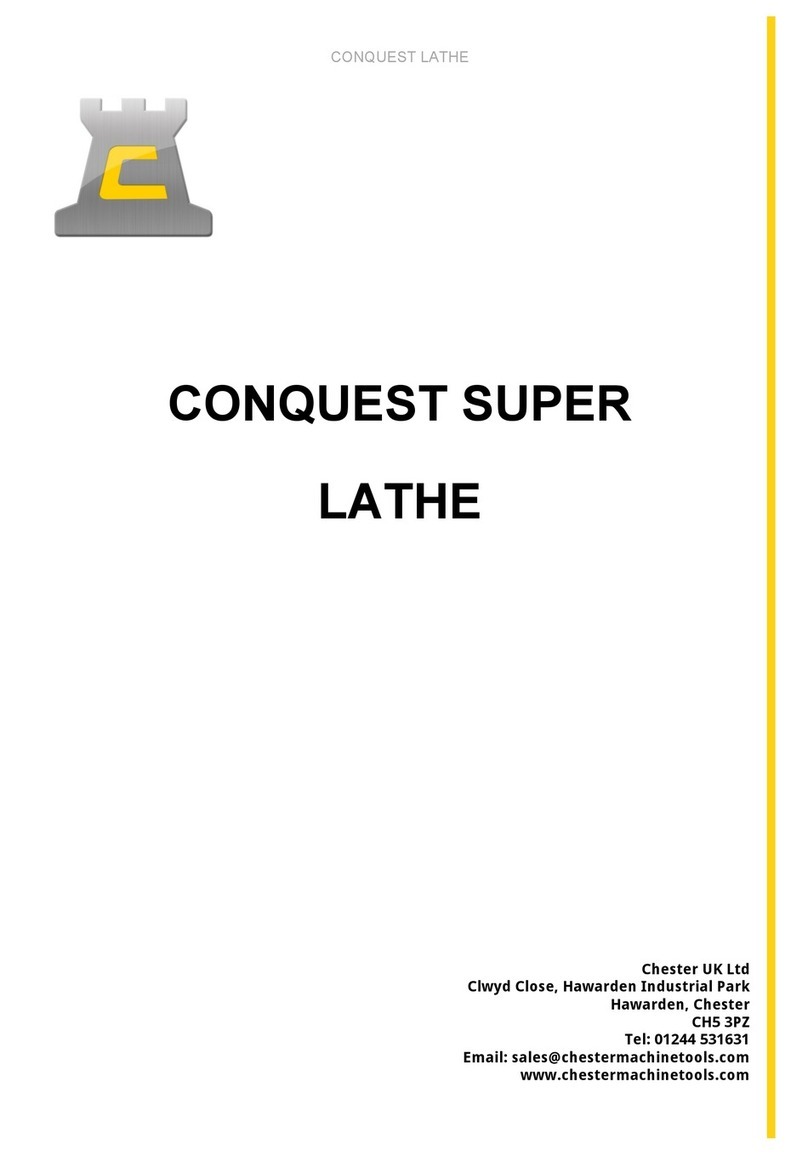
CHESTER
CHESTER CONQUEST SUPER LATHE User manual

CHESTER
CHESTER CONQUEST SUPER User manual
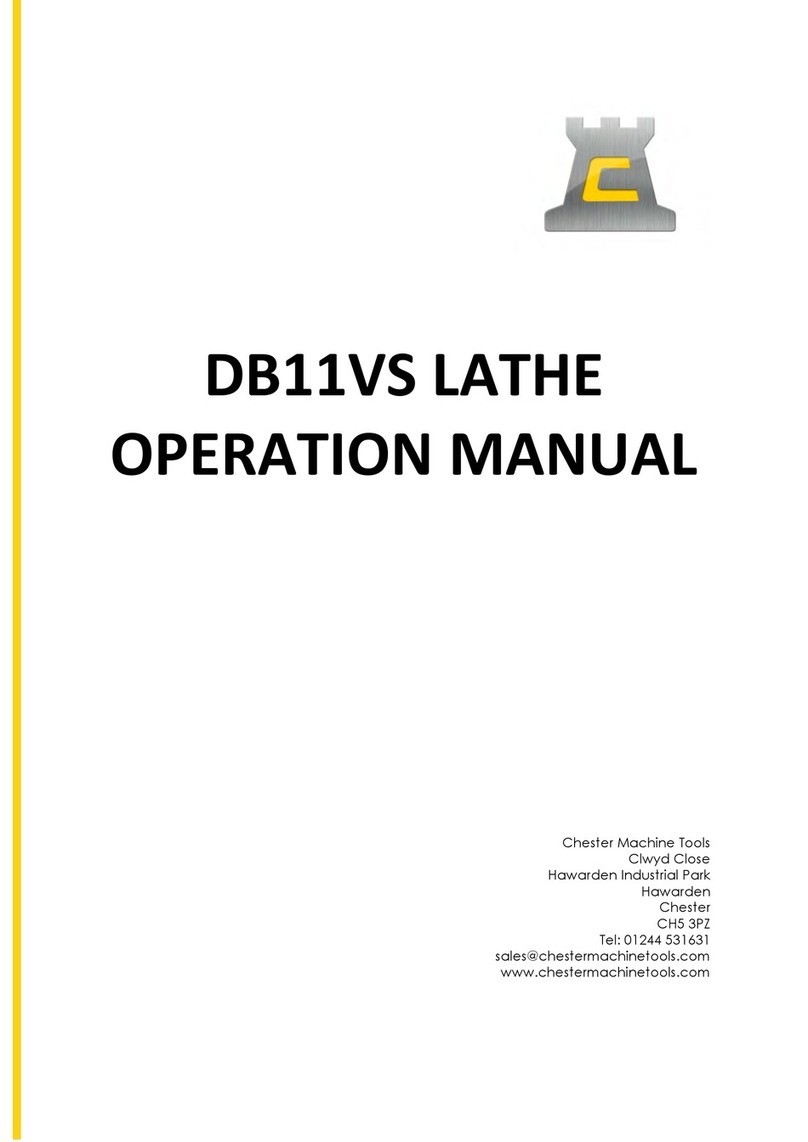
CHESTER
CHESTER DB11VS User manual
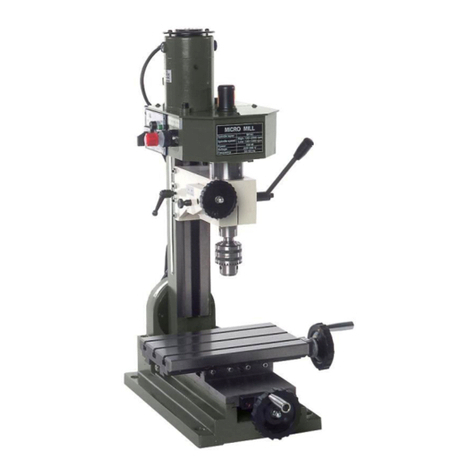
CHESTER
CHESTER Cobra Mill User manual
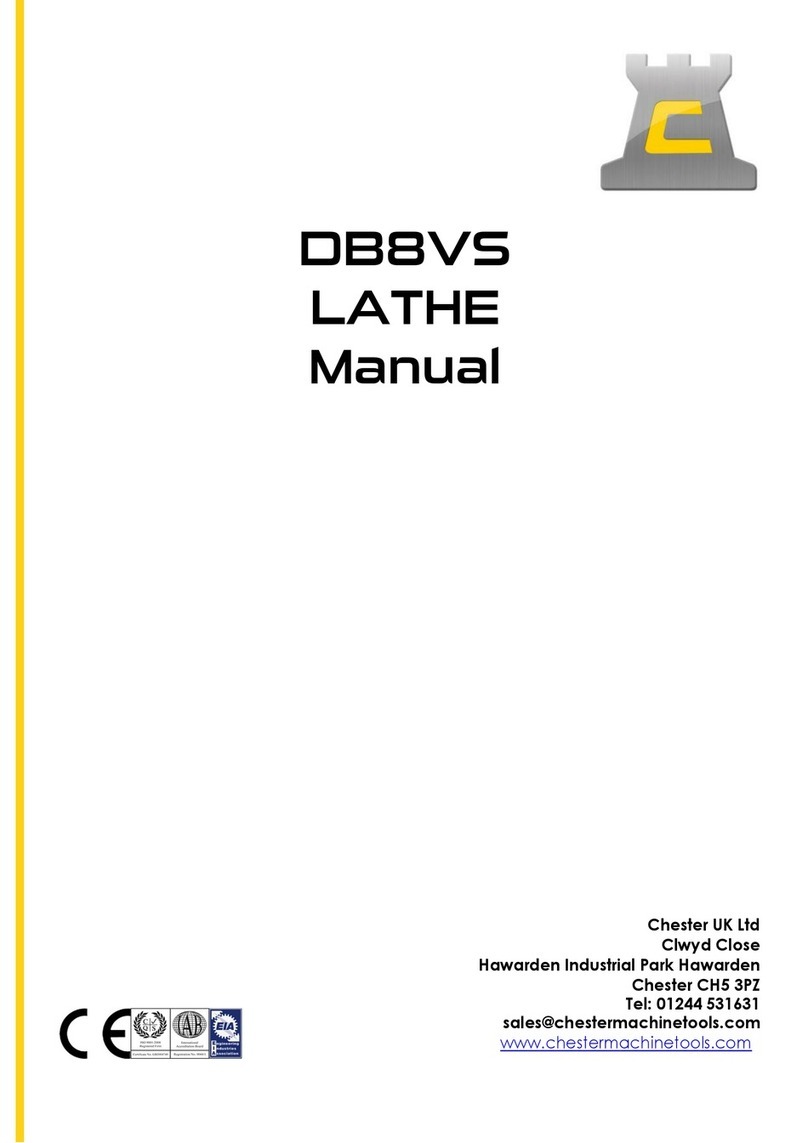
CHESTER
CHESTER DB8VS User manual
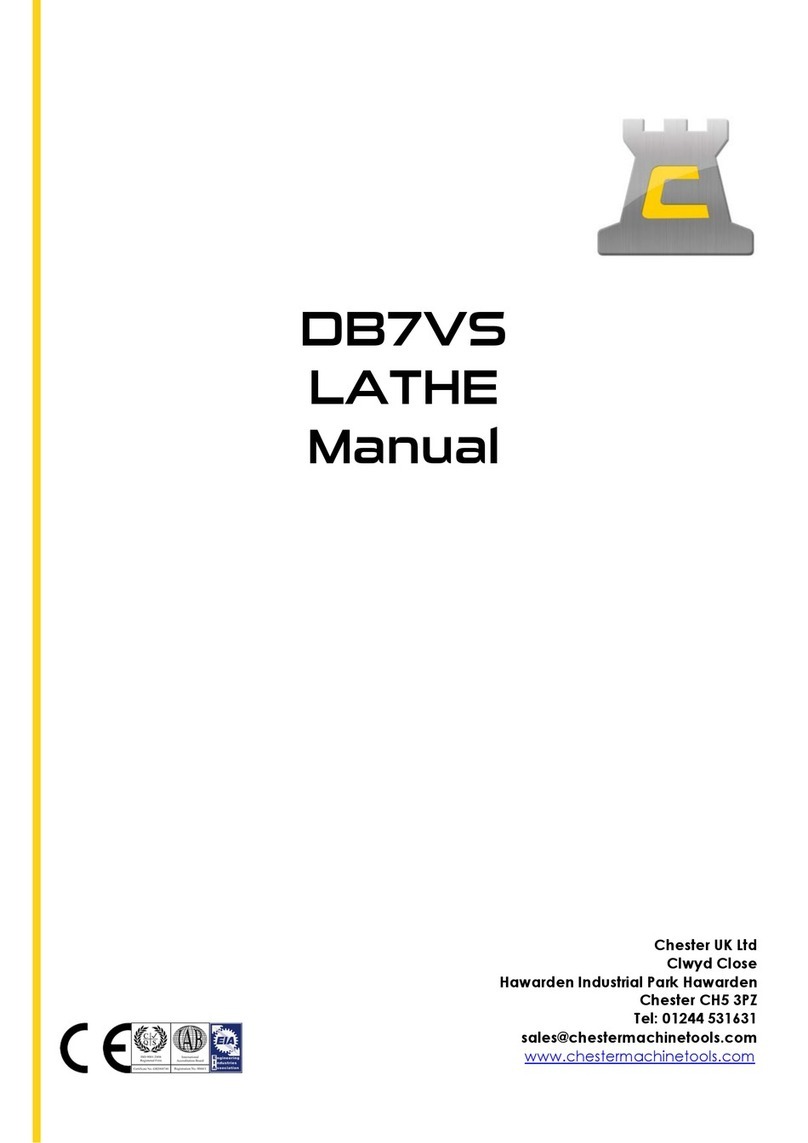
CHESTER
CHESTER DB7VS User manual
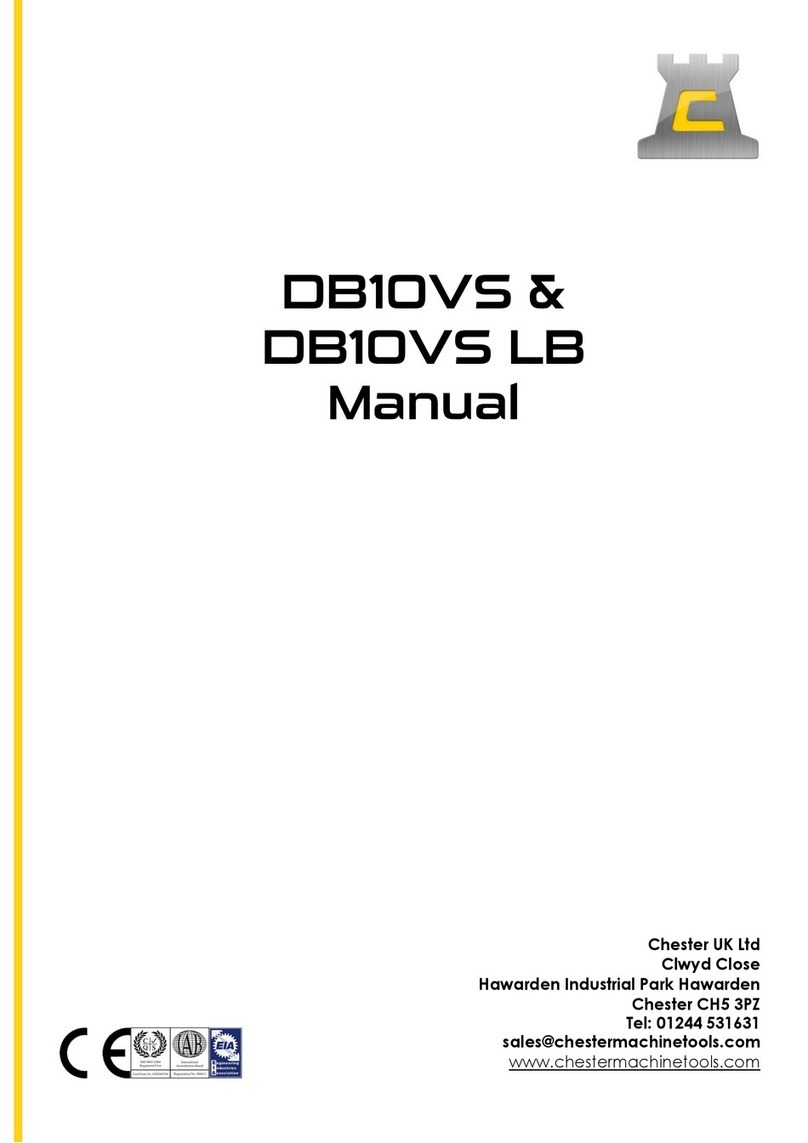
CHESTER
CHESTER DB10VS User manual
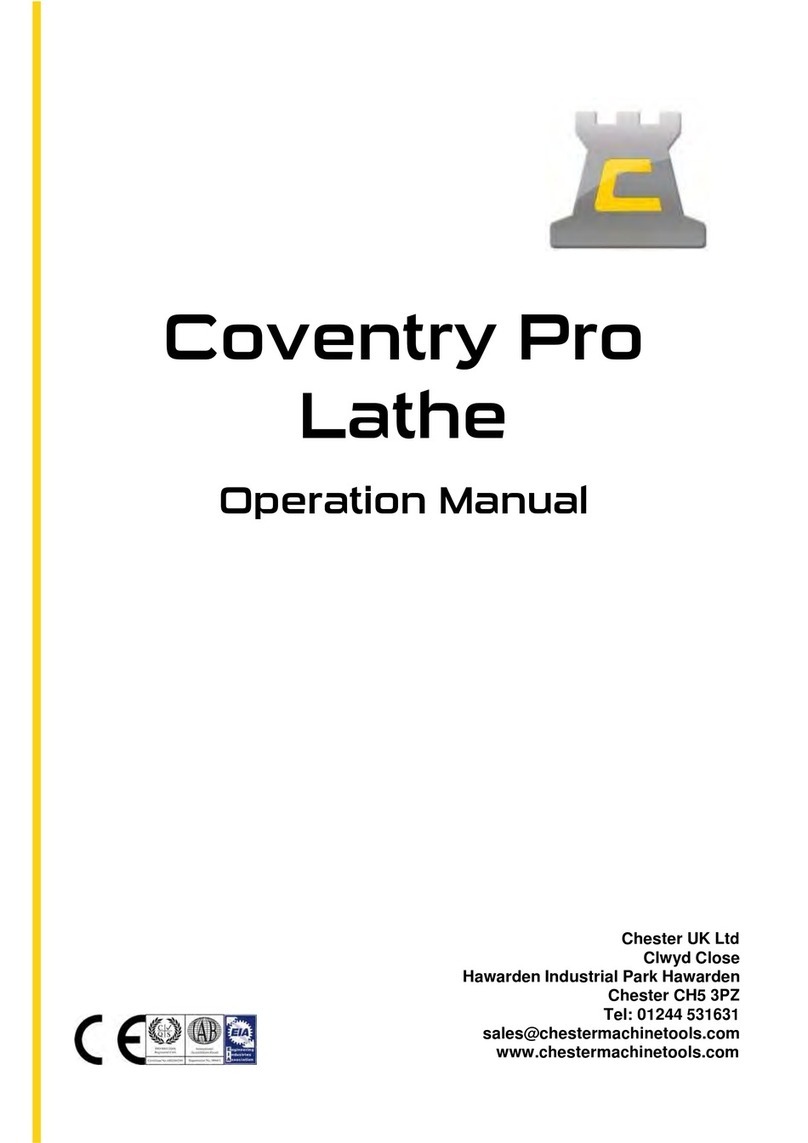
CHESTER
CHESTER Coventry Pro User manual
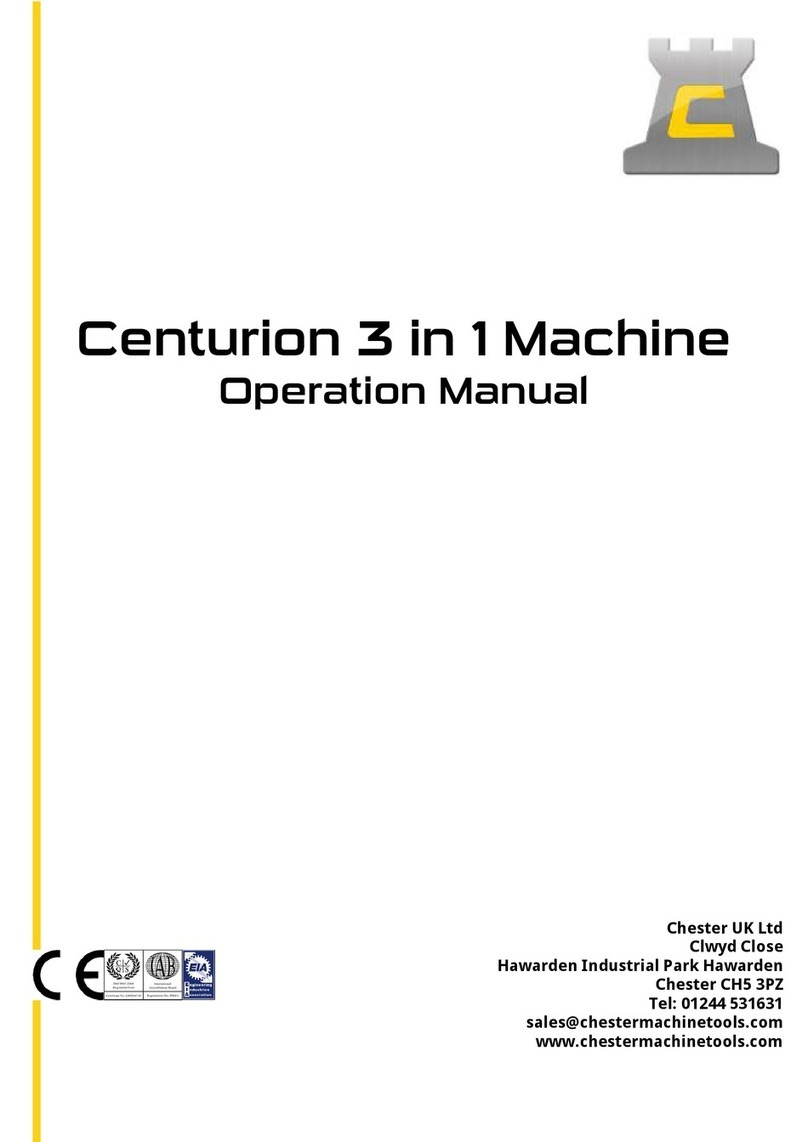
CHESTER
CHESTER Centurion Series User manual
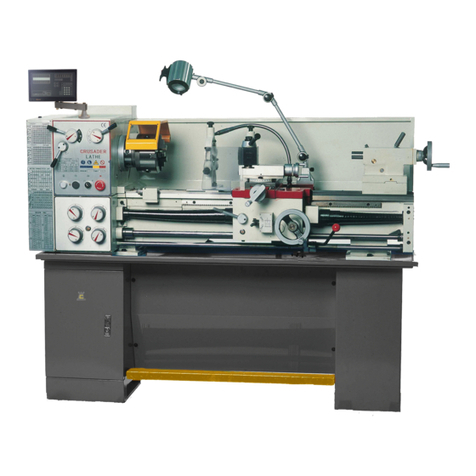
CHESTER
CHESTER Crusader Deluxe Lathe User manual


